1. INTRODUCTION
Biorefinery processes involve the use of a renewable carbon source to minimize the amount of waste generated, or even to exploit industrial residues. The biorefinery concept has emerged in recent years, with the aim of developing integrated processes for the conversion of biomass into energy and a variety of products, mainly biofuels and value-added by-products, in a sustainable manner (Cherubini, 2010). Many types of lignocellulosic biomass can be utilized as raw materials in a biorefinery, including softwoods, hardwoods, and herbaceous materials such as energy crops and agricultural residues (Cai et al., 2017; Lee et al., 2019).
In a biorefinery, pretreatment is required to separate the components of lignocellulosic biomass (Alvira et al., 2010; Kim et al., 2019; Kim et al., 2015). Steam explosion pretreatment is a simple, low-cost, and environmentally friendly technology that causes the depolymerization of hemicellulose into soluble oligomers and their transformation to lignin, taking advantage of its high temperature profile (Li et al., 2007; Jung and Yang, 2016). During steam explosion, some of the lignocellulosic biomass becomes solubilized as polymers or monomers, while the other parts become degraded or transformed into new components. However, studies on the steam explosion of lignocelluloses have mainly focused on their lignin and cellulose fractions. While the processes regarding the fractionation of biomass into an isolated, solid, cellulose-rich fraction and a lignin-rich fraction are well understood, the isolation of heteropolysaccharides in polymeric forms, which are useful in a variety of polymer applications, has not yet been addressed in relation to steam explosion (Sun et al., 2002).
Water-soluble fertilizers are a special class of fertilizers that hold promise in applications such as protected cultivation, hydroponics/aeroponics, or even open field hydroponics for perennial fruit crops. In addition, water-soluble fertilizers are used in sprinkler or drip irrigation systems and for foliar spraying to increase the yield and improve the quality of fruit and vegetable crops (Malhotra, 2016). Water-soluble fertilizers provide an enormous possibility of tailoring nutrient use across critical growth stages, a prerequisite for better nutrient use efficiency. These are mostly combinations of nitrogen, phosphorus, potassium, calcium, magnesium, sulfur, and other micronutrients at different ratios (Rajput and Patel, 2002). Modern agriculture is searching for new biotechnologies that would allow for a reduction in chemical inputs without negatively affecting crop yield or farmers' incomes.
During the manufacture of sugar, molasses is a by-product that is left after most of the sugar from sugar cane or sugar beets has been extracted. It increases the shoot length, leaf number per plant, leaf area, and chlorophyll content of peas. The sugar content in dry molasses also increases microbial activity, which, in turn, increases the availability of micronutrients to plants and encourages the growth of beneficial microorganisms. Molasses can be easily added to scores of organic liquid fertilizers such as kelp, alfalfa meal tea, and compost tea to give plants the necessary carbohydrates they need (Shirgure and Srivastava, 2014; Shehata et al., 2011).
The softwood, such as pine contain a large amount of hemicellulose. Also, pine is one of the major plantation tree species in the Republic of Korea (Lee et al., 2020; Min et al., 2019; Jung et al., 2019). It is considered that the liquid fraction containing hemicellulosic sugar (Jung and Yang, 2018), such as molasses, generated during the pretreatment stage in a biorefinery can serve as a fertilizer. Lettuce (Lactuca sativa) is one of the most important vegetables in the world, and is the main crop in plant factories (Nicolle et al., 2004, Dupont et al., 2000). Therefore, the present study aimed to determine the effect of using steam-exploded pine extract as a water-soluble fertilizer for the growth of Lactuca sativa. All data obtained during this study were evaluated via principal component analysis (PCA) for the growth of Lactuca sativa using water-soluble fertilizer.
2. MATERIALS and METHODS
Pine (Pinus densiflora) was collected from the experimental forest of Gyeongsang National University, Jinju, South Korea. The pine was chipped to a particle size of approximately 2 × 2 × 0.5 cm3 for steam explosion and stored at 20℃ at a moisture level below 10%-15%.
The chipped raw material was then exploded with steam (severity factor [Ro] = 3.86, 197℃, 10 min) to maximize the soluble carbohydrate content. The severity factor (Ro) was calculated using the following equation (De Bari et al., 2002): Severity log (Ro) = log[t×exp(T-100/14.75)], where t is the residence time in minutes, and T is the reaction temperature in ℃. Then, hot water extraction (90℃, 120 min, 1/39 [w/v]) was carried out to extract (Jung and Yang, 2018) low molecular weight carbohydrates. Consequently, filtration was conducted for further refinement.
Water-soluble fertilizer was prepared by mixing the wood extract with commercially available nutrients. Commercially available nutrients included ascorbic acid (F1), magnesium sulfate (F2), citric acid (F3), potassium nitrate (F4), amino acid (F5), and seaweed extract (F6). Water was used as a control (DW). The ratios of each formulation to each nutrient solution are shown in Table 1.
The plant material used to evaluate the suitability of the nutrient solution as a growth enhancer was lettuce (Lactuca sativa). Lettuce seeds were surface sterilized via immersion in 10% sodium hypochlorite solution for 10 min, rinsed three times with deionized water, soaked in deionized water for 2 h, and finally sown in the prepared mixture substrate.
In the pot experiment, after filling the growing media (peatmoss, perlite, vermiculite) in a 105-cell plug tray, 1 to 2 seeds per cell were sown and seeded for 14 to 18 days. Upon the appearance of three to four leaves, the same growing medium was filled in a cylindrical plastic container with a diameter of 10 cm and a height of 8 cm, then the plants were transplanted one by one into these containers. To these, 20 mL of the wood extract (formulations 1 to 6) were supplied every day (the control was supplied with water only). The average temperatures during the day and night were 30℃ and 18℃, respectively. The relative humidity was 37.1%-61.2% during the growth period. According to the plant water requirements, irrigation was performed one to three times per day. After sample collection at 2 weeks, a growth test (five repetitions, total number of samples = 80) was performed. Three heads were randomly selected from each variety during harvest. Different aspects of plant growth were determined, including plant height, number of leaves, leaf length, SPAD value (leaf chlorophyll), shoot fresh weight, root fresh weight, shoot dry weight, and root dry weight, and were measured at the end of the growth period.
The plant height was measured using Vernier calipers (Mitutoyo, model 500-144B, Tokio, Japan), from the ground to the apex of the plastic container in which the plants were planted (Lee et al., 2013).
The number of leaves that was 1 cm or more were counted. Leaf length was measured using the third to fourth largest leaf from the top (Kim et al., 2005).
SPAD measurements were performed using a SPAD-502 chlorophyll meter (Minolta Co. Ltd., Osaka, Japan). Measurements were taken using the flag leaves of five randomly selected plants within each plot. For each plant, the average of three SPAD readings around the midpoint of the flag leaves was taken.
The fresh weight and dry weight of lettuce separated by the shoots and roots were measured with an electronic scale (model SBA 51; Scaltec Instruments, Goettingen, Germany). The shoots and roots used for the measurement of dry weight were dried for 3 days in an oven maintained at a temperature of 70℃ (OF-22GW, Jeio Tech, Seoul, Korea).
The carbohydrate composition of the wood extract was determined by the National Renewable Energy Laboratory (NREL) using standard biomass analytical procedures (Sluiter et al., 2005). The arabinose, xylose, mannose, galactose, and glucose levels were determined using high-performance liquid chromatography (HPLC). The HPLC (Agilent, USA) system used was equipped with an Aminex HPX-87P column (Bio-Rad, Hercules, CA), a guard column, an automated sampler, a gradient pump, and a refractive index detector. The mobile phase was deionized water at a flow rate of 0.6 mL/min at 85℃. Prior to HPLC injection, all samples were neutralized with calcium carbonate and filtered through 0.2-µm syringe filters.
All experiments were performed in triplicates. Data were analyzed using SAS statistical software, and Duncan's multiple range test was used for the comparison of treatment means when P-values were significant at P < 0.05. The correlation between water-soluble fertilizer and growth was established via principal component analysis (PCA) using JMP software (version 16; SAS Institute).
3. RESULTS and DISCUSSION
The major biomass constituents, including hemicellulose, cellulose, and lignin, were relatively sensitive to the treatment temperature. At approximately 200℃, hemicellulose and lignin started to degrade; macromolecules of the hemicelluloses started to decompose to their corresponding oligomeric fragments, then short chains are depolymerized to monomer units and subsequently decomposed to volatiles, but only to a small extent (Shoulaifar et al., 2014).
The carbohydrate compositions of the wood extracts used in this study are presented in Table 2. The wood extracts contained carbohydrates. Based on HPLC carbohydrate analysis, the sugar fraction was 16.5% of the dry biomass. Mannose, the major hemicellulose constituent, accounted for 7.9%. Arabinose (0.5%), xylose (2.1%) and galactose (2.3%), and accounted for a small portion of the biomass. Glucose, which was derived from both the pinewood fiber and plant cell wall, was 3.7%. The wood extract obtained from steam-exploded pine (197℃, 10 min) was mainly composed of hemicellulose sugar (xylose, mannose, galactose, and arabinose). Also, the pH of wood extract was about 5.7.
| Composition | g/100 g raw material |
|---|---|
| Carbohydrate | |
| Arabinose | 0.5 |
| Xylose | 2.1 |
| Mannose | 7.9 |
| Galactose | 2.3 |
| Glucose | 3.7 |
The effects of wood extract or wood extract with some nutrients on the changes in plant height were investigated (Fig. 1). Significant differences in leaf area were observed among the eight treatments (DW, wood extract, F1, F2, F3, F4, F5, and F6). It is worth mentioning that the application of steam-exploded pine extract either alone or with ascorbic acid, magnesium sulfate, citric acid, potassium nitrate, amino acid, or seaweed extract significantly increased the plant height compared with the control (DW; 13.5 cm). The setups treated with pine extract alone showed the highest plant height (18.6 cm). Among the treatments F1, F2, F3, F4, F5, and F6, in which nutrients were added to water, F2 (containing magnesium sulfate) showed the lowest plant height (15.3 cm). There were no significant differences in the plant heights in the F1- (16.5 cm), F3- (17.0 cm), F4- (18.2 cm), F5- (17.9 cm), and F6- (17.2 cm) treated samples.
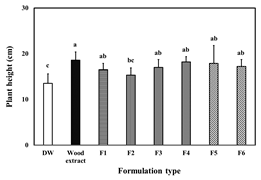
Fig. 2 shows the changes in the number of lettuce leaves upon the addition of pine extract and some nutrients. Water-soluble fertilizers significantly affected leaf number, and the highest leaf numbers were found in the plants treated with wood extract (10), F3 (10), F4 (10), and F5 (10), while the DW-treated samples had the least number of leaves (control; 7). No significant differences in leaf number were found between F1 (9), F2 (8), and F6 (9).
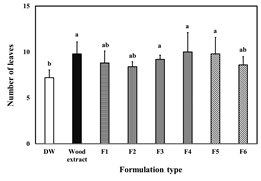
The wood extract, nutrients, and their interactions exhibited a prominent effect on lettuce leaf length (Fig. 3). Maximum leaf length was observed in the plants treated with wood extract (14.1 cm) and F5 (13.6 cm).
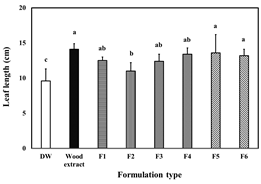
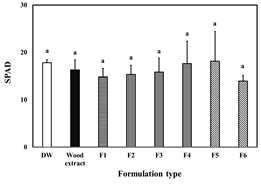
SPAD-502 (Minolta Ltd., Osaka, Japan) is a handheld chlorophyll meter that indirectly determines leaf chlorophyll content. It measures the leaf transmittance in red light at 650 nm (at which chlorophyll absorbs) and in near-infrared light at 940 nm (for the correction of leaf thickness). The ratio of these two transmission values is referred to as the SPAD (Soil Plant Analysis Development) reading or SPAD value (Hoel and Solhaug, 1998). A decrease in the SPAD value indicates an increase in the red color of the Lactuca sativa used. The SPAD values of the wood extract, F1, F2, F3, F4, F5, and F6 treatments ranged from 14.0 to 18.1, while that of DW was 17.8. While there were numerical differences in SPAD values, they were not significant (P > 0.05).
The resulting fresh and dry weights of lettuce upon the application of water-soluble fertilizers are shown in Fig. 5 and 6. Fig. 5 shows the fresh weights of lettuce by dividing them into shoots (Fig. 5(a)) and roots (Fig. 5(b)). The fresh weight of shoots was highest in the lettuce treated with wood extract (9.8 g/plant) and F5 (7.4 g/plant). The fresh weights of lettuce treated with F1 (6.5 g/plant), F2 (4.8 g/plant), F3 (7.0 g/plant), F4 (6.6 g/plant), and F6 (5.5 g/plant) were higher than that of the control (5.3 g/plant), but there was no statistically significant difference between them. On the other hand, the fresh weight of the roots was reduced in the lettuce treated with F1 (0.5 g/plant), F2 (0.4 g/plant), F3 (0.5 g/plant), F4 (0.3 g/plant), F5 (0.4 g/plant), and F6 (0.2 g/plant), compared to the control (0.7 g/plant); however, the fresh weight of lettuce treated with wood extract (0.8 g/plant) increased. Fig. 6 shows the dry weight of the shoots (Fig. 6(a)) and roots (Fig. 6(b)) of lettuce to which different water-soluble fertilizers were applied. The dry weight of the shoot was higher in the lettuce treated with wood extract (0.6 g/plant) and F5 (0.5 g/plant), while the dry weights of the lettuce treated with F1 (0.4 g/plant), F2 (0.3 g/plant) and F6 (0.3 g/plant) were lower than that of the control (0.4 g/plant). The dry weight of lettuce roots to which other types of water-soluble fertilizers were applied showed a small value, in the range of 0.03 g/plant to 0.07 g/plant, and were not significantly different compared to the control (0.07 g/plant).
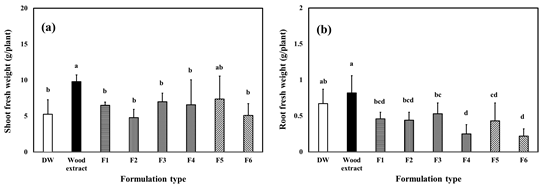
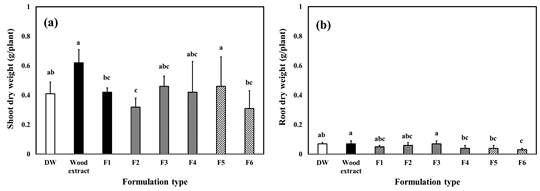
The relationship between water-soluble fertilizers, (DW [control], wood extract, F1, F2, F3, F4, F5, and F6) and the growth of Lactuca sativa was determined via principal component analysis (PCA) (Fig. 7). A set of seven principal components was generated using PCA. The first principal component had the highest eigenvalue (4.1) and accounted for 50.7% of the variability in the data set. The second had an eigenvalue of 2.9, accounting for 35.7% of the variance in the data. Only principal components 1 and 2, which have eigenvalues higher than 1.0, were considered significant descriptors of data variance in this study according to Kaiser's rule. Principal components 1 and 2 explained 86.4% of the observed effects. Treatment with wood extract was positively correlated with SPAD value, root fresh weight, shoot fresh weight, and shoot dry weight. The hemicellulosic sugar contained in the wood extract was considered to have an effect on the growth of lettuce (Table 1). Yi et al. (2019) reported that wood-derived biochar amendment increased yield of Lettuce as well as improving soil properties. Noh et al. (2020) reported that the growth of lettuce was decreased due to the reactive oxygen species such as ozone in the plasma-activated water, but the secondary metabolites in the root zone increased significantly. The wood-derived extract is considered to have potential as an alternative source of water-soluble fertilizers for the growth of lettuce.
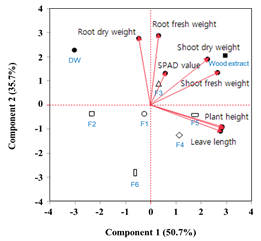
4. CONCLUSION
The application of wood extract influenced the growth characteristics of lettuce. Our experimental results show that providing lettuce with water-soluble fertilizers has beneficial effects in plant height, number of leaves, leaf length, shoot fresh weight, root fresh weight, and shoot dry weight. Application of wood extract did not show significantly positive effects in SPAD value and shoot dry weight. PCA analysis showed that wood extract was positively correlated with SPAD value, root fresh weight, shoot fresh weight, and shoot dry weight. This was considered to be related to the hemicellulose sugar content in the wood extract. Overall, these results indicate the possibility of using extracts as water-soluble fertilizers, and further studies on the relationship between hemicellulosic sugar and the growth characteristics of plants should be conducted in the future.
